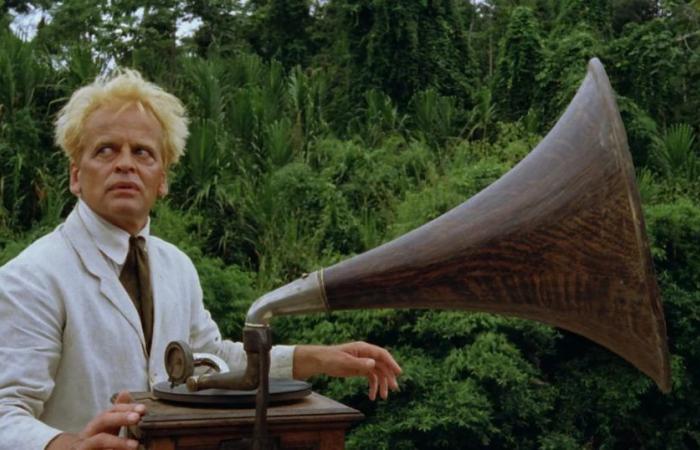
A sadistic megalomaniac or a visionary hero? Known as “the king of rubber”, Carlos Fermin Fitzcarrald He was a poor and lonely man who, in 1891, entered the depths of the Peruvian Amazon. Ten years later, he had become a millionaire merchant after discovering an isthmus that joined two rivers, facilitating the rubber trade in his country and other destinations such as Bolivia, Brazil, Europe and the United States.
This discovery is remembered as one of the most important discoveries of the 19th century, and also involved the construction of roads and other infrastructure necessary to transport the products. However, Fitzcarrald’s success came at the cost of the exploitation and death of indigenous people, whom he coerced and violated to subject them to extremely hard work. His method was replicated by other businessmen, in a period widely remembered as “rubber fever”.
Marveled by this story, the German director Werner Herzog He wanted to bring the explorer’s life to the cinema. At that time, the filmmaker was famous for filming in remote locations, as he considered that studios “killed spontaneity.” His obsession with the “authentic” had led him to contract malaria on several occasions, in addition to putting his actors through hell. Even so, together with his team, he traveled to the Amazon and was interned for three years to release in 1982, Fitzcarraldo.
The plot, told through a heroic lens, follows Brian Sweeney Fitzgerald, an eccentric classical music lover who lives in the city of Iquitos. His peculiar goal is to build a grand opera in the middle of the Amazon jungle and bring his favorite tenor, Enrico Caruso, to sing there.
Although the idea had no coherence in monetary terms, he decided to finance his dream by entering the lucrative rubber business. This is how he finds out that there is a very promising reserve, but inaccessible due to its location, on the other side of a mountain. Committed to making the impossible real, Fitzcarraldo devises an audacious plan: drag a large steamboat over the mountain to access the rubber trees with the help of a group of local indigenous people.
Following his debut at the Cannes Film Festival, Werner Herzog was awarded the Best Director award. The film would achieve cult status, being recognized for its stunning special effects-free cinematography. Little was said about the fact that the production was barbaric. In the name of art, some indigenous people and local residents ended up dead or injured, riots were caused in native communities, and feats that bordered on madness were performed.
Later, the Peruvian anthropologist who was part of the project revealed that Herzog had become Fitzcarraldo. “In the middle of the Amazon he ended up acting just like him”, assured Cesar Vivanco.
During the start of filming, Jason Robards (Magnolia, once upon a time in the west) was chosen to star in the film alongside Mick Jagger, the famous leader of the Rolling Stones, played by Fitzcarraldo’s assistant Wilbur. The duo sparked curiosity about the production, until Robards fell ill with dysentery, and flew back to the United States to treat the bacterial infection. When he tried to return to Peru, his doctor forbade him to travel, so all of his work, including that of the rock star, was discarded.
The setback led Herzog to reconfigure the cast, this time with Klaus Kinski in the main role. The director and actor had already worked together in the Peruvian jungle on the film Aguirre, the wrath of God. The relationship between the two was terrible. According to countless testimonies, Kinski tended to get angry at the slightest situation, yelling at the team, threatening them with weapons and even attacking them unceremoniously.
The fights with the director reached an extreme when Herzog pointed a rifle at him and promised that he would shoot him and then commit suicide if Kinski insisted on leaving the shoot. The filmmaker himself confessed that the leader of a native community offered to murder the actor, which he refused because some scenes still needed to be filmed.
“We had a great love, a great bond, but we both planned to kill each other. Klaus was one of the best actors of the century, but he was also a monster and a great pestilence. Every day I had to think of new ways to tame the beast,” Kinski said after the Cannes premiere.
That was just the tip of the iceberg. The main feat of the script involved moving with pulleys a 320 ton steamship on a hill In real life, Carlos Fermín Fitzcarrald carried out a similar project, but the boat weighed only 30 tons and was transported in parts to be impounded at the end of the destination.
The Brazilian engineer who had to ensure that this insane idea was carried out warned that there was a 70% chance that the plan would fail and the weight of the boat would kill the team and the extras. He resigned after Herzog completely ignored him, and hired 400 Aguaruna and Gran Pajonal natives to act as Fitzcarraldo’s day laborers.
But as noted, During the first attempt, one of the cables broke and the boat fell backwards, killing one of the indigenous people on the spot. The community mourned the loss of their partner and the project was stopped because they refused to continue working.
By that time, the exact number of extras who had died was already in the dozens, but the main causes had been diseases, such as malaria and hepatitis. Other reasons were also mentioned, such as violence carried out by the team and conflicts with neighboring tribes, but due to the social and temporal context, there is no evidence to support this.
In 1982, anthropologist Michael F. Brown wrote in the journal The Progressive that the Aguaruna shot an arrow in the neck of an actor and set fire to the set after Herzog built a village on their land, forcing them to rebuild the main location.
In the documentary Burden of Dreams, which showed behind the scenes of the film, the director is heard trying to convince the natives to return to the set, promising them land and even weapons. “He offered them shotguns to stay. Do you know what it means in the Amazon to introduce only ten shotguns? Well, he gave about forty to the bosses with whom he negotiated. “I wanted to avoid all that, I couldn’t and I left,” said the aforementioned anthropologist in an interview with The evil thinker.
The documentary also showed a team member who was bitten by a poisonous snake and whose life was saved by amputating his foot with a chainsaw. In addition, the cinematographer ended up with a hand amputated and sewn without anesthesia after an accident on the steamboat.
During the premiere of Fitzcarraldo, all of these experiences were proudly recounted, and Herzog’s obsession was seen as an example of passion and artistic genius. The German Film Awards considered it the best film of the year, and critic Roger Ebert said it had one of the “best visions of cinema.”
Herzog was sure that no one would repeat his feat due to how absurd and crazy it was, calling himself the “Conqueror of the Useless”. And although no one has tried it so far, series like Narcos and movies like The Lost City of Z, The Godfather III and more recently, Paddington in Peru They honored and referenced this controversial and epic feature film.





